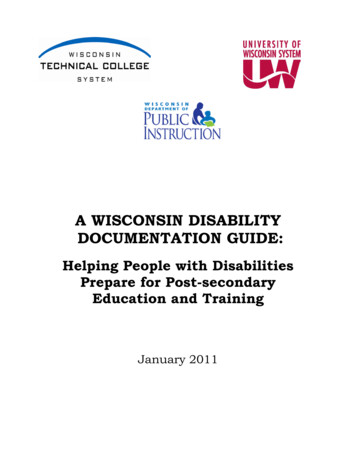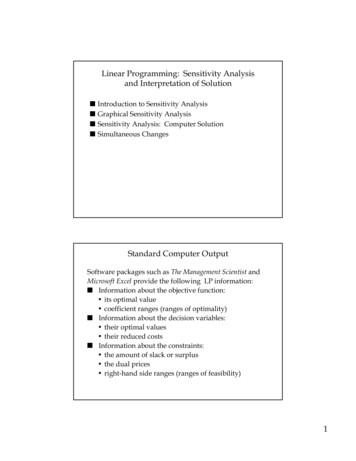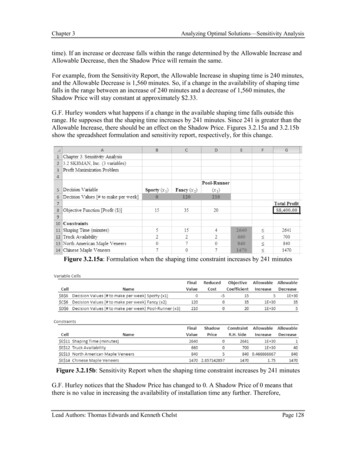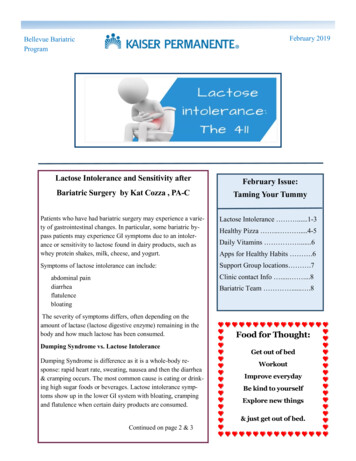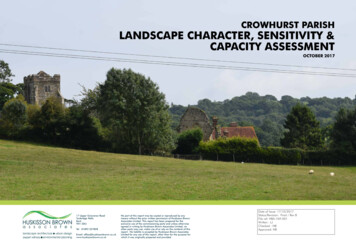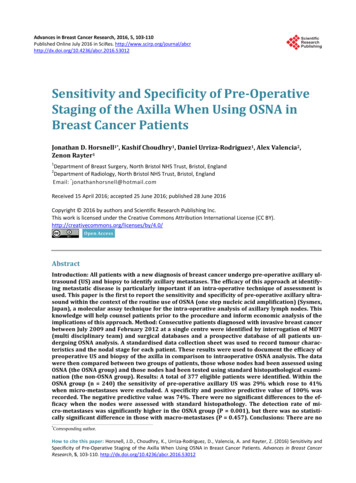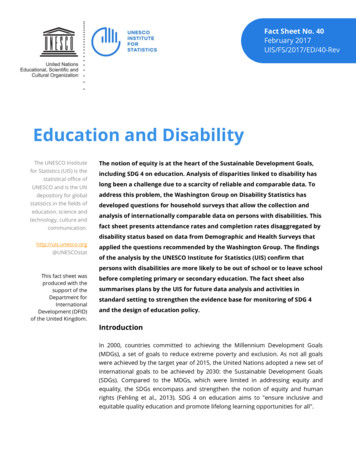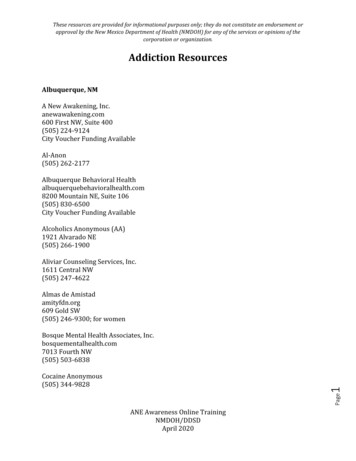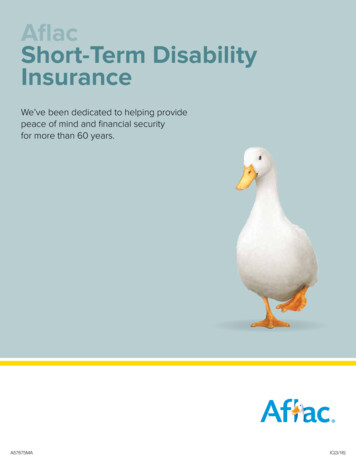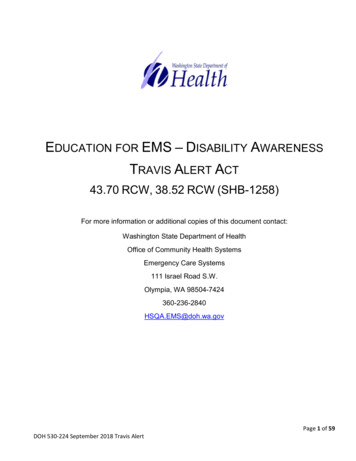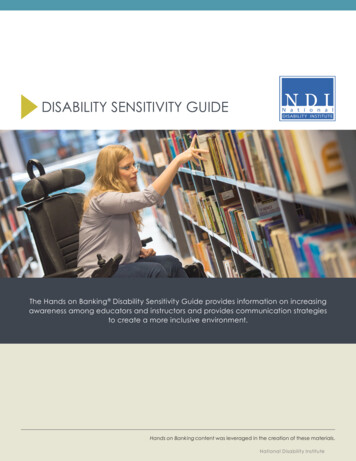
Transcription
DISABILITY SENSITIVITY GUIDEThe Hands on Banking Disability Sensitivity Guide provides information on increasingawareness among educators and instructors and provides communication strategiesto create a more inclusive environment.Hands on Banking content was leveraged in the creation of these materials.National Disability Institute1
AcknowledgementsThis guide was developed by National Disability Institute’s Training and Technical Assistance Team.National Disability Institute is a national research and development organization with the mission todrive social impact to build a better economic future for people with disabilities and their families.National Disability Institute’s Real Economic Impact (REI) Network is comprised of an alliance oforganizations and individuals dedicated to advancing the economic empowerment of people withdisabilities. The network consists of more than 4,500 partners in all 50 states.Members include nonprofits, community tax coalitions, asset development organizations, financialeducation initiatives, corporations and private-sector businesses, federal/state/local governments andagencies, and individuals and families with disabilities. All partners join forces to embrace, promote,pursue access to and the inclusion of people with disabilities in the economic mainstream.To learn more about how to make a Real Economic Impact, join us: www.realeconomicimpact.org.For more information about the guide, please send an email to: ask@ndi-inc.org.National Disability Institute would like to thank Wells Fargo for their support of the DisabilitySensitivity Guide.2Disability Sensitivity Guide
Financial Education Tools and ResourcesOVERVIEW OF HANDS ON BANKING Hands on Banking /El futuro en tus manos (handsonbanking.org/ndi) is a free, fun,non-commercial financial education programavailable in both English and Spanish thatteaches people, in all stages of life, about thebasics of responsible money management,including how to create a budget, save andinvest, borrow responsibly, buy a home, andestablish a small business.Hands on Banking offers flexibility in the waysinformation can be delivered in the AmericanJob Centers. The program includes individualresources and instructor guides with tools anddetailed information on content, activities, andtips on how to deliver the information.Hands on Banking can be offered as aworkshop or job seekers can access theonline program, courses and more athandsonbanking.org/ndiProgram Highlights Available online with printed instructor guides; Courses for kids, teens, young adults,and adults; Financial fundamentals for entrepreneurs; Personal finance lessons for members ofthe military, seniors, and their families; Resources for individuals, educators,non-profits, and workplace Available in English and Spanish; Designed for individual or classroom learning; Aligns with state and national educationstandards for mathematics, reading,and economics; Free, non-commercial content; Animated, interactive, and entertaining; and Easy to navigate and fun to present.National Disability Institute3
TABLE OF CONTENTSPersons with Disabilities:Understanding the Community5Different Types of Disabilities5EXAMPLES OF DIFFERENT TYPES OFDISABILITIES 6TIPS FOR INTERACTING WITH SERVICEANIMALS AND THEIR OWNERS10EXPECTED BEHAVIORS REGARDINGSERVICE ANIMALS10MYTHS AND STEREOTYPES6Effective Communication7Strategies to Make Your WorkshopAccessible and Inclusive to Personswith Disabilities 11PEOPLE FIRST LANGUAGE7REASONABLE ACCOMMODATIONS11EFFECTIVE COMMUNICATION TIPS7More Information/Resources11Accessibility Checklist12TIPS FOR COMMUNICATING WITHSPECIFIC POPULATIONSTips for Communicating with IndividualsWho Are Blind or Have Low Vision88Tips for Communicating/Interactingwith Individuals Who AreDeaf/Hard of Hearing84Service Animals 10Tips for Communicating with Individualswith Limited Mobility9Tips for Communicating with Individualswith Speech Disorders9Tips for Communicating with Individualswith Intellectual and/orDevelopmental Disabilities9Disability Sensitivity Guide
DISABILITY SENSITIVITY GUIDEThe Hands on Banking Disability Sensitivity Guide provides additional information specific to adultswith disabilities. Each of the topics and lessons provided in the Hands on Banking instructor guides areimportant topics for people with disabilities to learn as well.The disability community is very diverse. Some individuals with a disability may be employed, while others mayrely on public benefits as their main sources of income. Some of the public benefits they receive might havelimitations. Income, resource and savings limits often prevent individuals from enhancing their financial wellbeing and self-sufficiency as they concentrate efforts on retaining their benefits. New and existing programsare available to help people with disabilities develop skills in financial management and self-sufficiency.This guide provides information on increasing awareness among educators and instructors and providescommunication strategies to create a more inclusive environment.An important characteristic of an effective instructor is being aware of diversity among the individuals towhom you are providing information. This supplemental guide will provide you with information, resourcesand tips on how to interact more effectively with people with disabilities, eliminate myths and increaseawareness of this growing demographic. It is important to assure that persons with disabilities have thesame experience in your training program as others.Persons with Disabilities: Understanding the CommunityThe disability community itself is extremely diverse. According to the U.S. Census, one in five individuals in the U.S.have a disability. The Americans with Disabilities Act (ADA) defines a person with a disability as someone who: Has a physical or mental impairment that substantially limits one or more major life activities, Has a record of such an impairment, or Is regarded as having such an impairment.The ADA protects people who have disabilities as they live their lives, participate in education, apply forwork and are hired as an employee of a business or are self-employed. People who have a disability areencouraged to have personal control over their finances and learn skills that help them to use safe andaffordable financial services. All people have the right to save their money, make purchases and own assetssuch as computers, recreational equipment, vehicles and homes.It is important to note there are other definitions of disability for different purposes. However, the material inthis supplemental guide is based on the ADA definition.Different Types of DisabilitiesThe definition provided by the Americans with Disabilities Act provides a broad definition of who isprotected and considered to be a person with a disability. Some individuals are born with a disability,while others may acquire their disability due to an accident, illness or as a part of the aging process.People with disabilities may have one or more areas in which their functioning is affected. A disability canaffect hearing, sight, communication, breathing, understanding, mobility, balance, concentration or mayinclude the loss of a limb. A disability may contribute to the way a person feels each day and affect theirmental health.National Disability Institute5
EXAMPLES OF DIFFERENT TYPES OF DISABILITIESHearing May include a person who is deaf or hard of hearingMobility May include a person who uses a wheelchair, cane or other assistive deviceIntellectual/Developmental May include a person who has Down syndrome, autism or cerebral palsyVisual May include a person who is blind or has low visionSpeech / Communication May include a person who has Aphasia or a stutterLearning May include a person who has dyslexia or ADHDMental Health/ Emotional Health Conditions May include a person who has bipolar disorder, depression or obsessive compulsive disorderDisability crosses all ethnicities, religions, social and financial backgrounds.KEEP IN MIND TIP: It is important to remember that persons with disabilities are PEOPLE first who have morein common with you than NOT and should be treated like everyone else.MYTHS AND STEREOTYPESWe are all individuals with commonalities and differences and that is true for persons with disabilities aswell. As an instructor, it is important to remember to not show pity or put an individual up on a pedestal –everyone should be treated as equals regardless of one’s abilities.When working with people with disabilities, it is important to avoid stereotypes. To debunk commonstereotypes and myths, below are some key items to note about persons with disabilities: Persons with disabilities are all ages, come from diverse cultures and financial backgrounds. People with disabilities work. People with disabilities have families. Not all persons with disabilities are on or receive benefits such as SSI, Medicaid, etc. People with disabilities have goals and dreams. All people with disabilities do not necessarily want or need assistance. People who are blind or have low vision may wear glasses. People who are deaf may use their voice and may be able to read lips, but not all. Not all people who use wheelchairs are completely paralyzed – some may be able to walk short distances. Delayed or slow speech is not necessarily a sign of a slowed mental process. Persons with learning disabilities can be highly intelligent individuals; they simply have a differentway of learning.6Disability Sensitivity Guide
Effective CommunicationCommunicating effectively and understanding your audience is key to being an effective instructor. Thefollowing are some key communication tips to assist instructors in communicating effectively with personswith different types of disabilities.PEOPLE FIRST LANGUAGEPositive language empowers people and helps them feel respected and important. When writing orspeaking about people who have a disability, it is important to put the person first, usually addressing themby name or including them as a member of a group, such as a student or co-worker. Group designationssuch as “the blind,” “the retarded” or “the disabled” are inappropriate because they do not reflect theindividuality, equality or dignity of people with disabilities.The following are examples of People First Language.Affirmative PhrasesNegative PhrasesPerson with an intellectual, cognitive, developmental disabilityRetarded; mentally defectivePerson who is blind; person who has low visionThe blindPerson with a disabilityThe disabled; handicappedPerson who is deaf*The deaf; deaf and dumbPerson who is hard of hearingSuffers a hearing lossPerson who has multiple sclerosisAfflicted by MSPerson with cerebral palsyCP victimPerson with epilepsy; person with seizure disorderEpilepticPerson who uses a wheelchairConfined or restricted to a wheelchairPerson who has muscular dystrophyStricken by MDPerson with a physical disability; person who is physically disabledCrippled; lame; deformedUnable to speak; uses synthetic speechDumb; mute*Individuals who identify as part of deaf culture and use American Sign Language (ASL) as their primarylanguage do not consider themselves as having a “disability.” Therefore, in this instance, it is appropriateto say “deaf person.”EFFECTIVE COMMUNICATION TIPSThe number one rule in effective communication with persons with disabilities is to “ask first” and then waitfor instructions on how you may assist or the best mode of communication with the individual. Peoplewith disabilities are like everyone else, they are People First who often want to be independent and livefulfilling, productive lives just as we all do.Sometimes a person who has a disability may ask for an accommodation that will help to ensure that theycan fully participate in an activity. An example could be to request to meet in a quiet setting or to have aninterpreter who facilitates a conversation over a phone or relay service. A person who has a disability knowswhat works best for them; feel comfortable to ask them what will help. When hosting an event, ask if anaccommodation is needed during the process of registration. This will provide the opportunity for people withdisabilities to let you know and give you time to make arrangements that will ensure they can fully participate.Here are some general tips to keep in mind: Offer to shake hands when introduced. People with limited hand use or an artificial limb can usuallyshake hands and offering the left hand is an acceptable greeting. Treat adults as adults! Address people with disabilities by their first names only when extending thatsame familiarity to all others.National Disability Institute7
ASK FIRST - If you offer assistance (always ask before assisting someone), then wait until the offer isaccepted. Then ask the individual with a disability for instructions on how you may assist them. RELAX. Don’t be embarrassed if you happen to use common expressions such as, “See you later” or“Did you hear about this?”, that seem to relate to a person’s disability.TIPS FOR COMMUNICATING WITH SPECIFIC POPULATIONSTips for Communicating with Individuals Who Are Blind or Have Low Vision When approaching, clearly state who you are, speaking in a normal tone of voice. Do not shout. When conversing in a group, remember to identify yourself and the person to whom you are speaking. Tell the individual if you are moving around or when you are leaving. Do not attempt to lead an individual without first asking; if they choose to do so, allow the person tohold your arm/elbow. Be descriptive and specific when giving directions. For example, if there are steps, mention how manyand location such as left or right. If you are offering a seat, either give verbal cues or, if acting as a guide, gently place the individual’shand on the back or arm of the chair so that the person can locate their seat.A person who is blind or has low vision may need written materials in an accessible format. The materialsmay need to be provided in Braille or recorded on a computer. A person may need someone to read thematerials aloud to them so they can understand the information and participate in activities.Tips for Communicating/Interacting with Individuals Who Are Deaf/Hard of Hearing Gain the person’s attention before starting a conversation (i.e., gently wave your hand in their line ofvision or tap the person gently on the shoulder or arm). If the individual uses a sign language interpreter, speak directly to the person, not the interpreter. American Sign Language (ASL) is not another form of English. It is an official language with its owngrammar, context and rules. Know that some people who are deaf speak quite clearly and others may be non-verbal. When speaking with someone who reads lips, look directly at the individual, face the light, speak clearlyin a normal tone of voice and keep your hands away from your face. Avoid smoking or chewing gum.A person who is deaf or hard of hearing may have a way that they prefer to communicate with others. Thismay change from setting to setting. A person may prefer to text back and forth, exchange e-mails or writenotes to communicate. In a classroom or group setting, a person may prefer to use a hearing loop thatsends the information to their hearing aid or converts the information into text called closed captioning.Another person may prefer to have a sign language interpreter in a classroom or group setting. It is bestto ask the person who is deaf or hard of hearing which mode of communication they would prefer. If theperson requests an interpreter, ask which type of interpreter they need.While writing or typing back and forth for simple banking procedures, like cashing a check or makinga deposit, may work well for a deaf or hard-of-hearing customer, sign language interpreters may berequested for more complex financial services like completing a loan application or opening a savingsaccount. Without an interpreter, a deaf customer can miss critical information to make informed decisionsabout their financial well-being. In order to request a qualified sign language interpreter, locate yourstate offices. They are mandated to serve people who are deaf and hard of hearing. Visit the NationalAssociation of the Deaf website (bit.ly/NAD-State-Agencies) for more information.8Disability Sensitivity Guide
Tips for Communicating with Individuals with Limited Mobility There is a wide range of physical ability among people who use wheelchairs, and people who usethem will likely require different degrees of assistance. If possible, put yourself at the wheelchair user’s eye level (especially if speaking to a person for morethan a few minutes). Do not lean on a wheelchair or any other assistive device. Never patronize people who use wheelchairs by patting them on the head or shoulder. Do not assume the individual wants to be pushed – ASK FIRST. When assisting in going up or down a curb, ask if he or she prefers going forward or backward. Whenpushing a wheelchair and entering an elevator, enter and turn the person around to face the openingdoors (not facing a wall). OFFER assistance if the individual appears to be having difficulty opening a door. Do not take mobility aids away from users unless they request it or it is required for safety reasons. If it isnecessary, let the user know exactly where their equipment is being placed. Sometimes people are told a place is accessible when it is not. Consider distance, weather andobstacles such as stairs, curbs or hills when you give directions.A person who has limited mobility may use a wheelchair, scooter, crutches or another device or assistivetechnology to help them to move about. If a person is seated in a wheelchair, you may want to sit downif the conversation is going to last more than a few minutes. This will allow you to have direct eye contactwith the individual.Tips for Communicating with Individuals with Speech Disorders If you do not understand something the individual says, do not pretend that you do. Ask the individualto repeat what he or she said and then repeat it back to them. Be patient and concentrate on what the individual is saying. Take as much time as necessary. Do not speak for the individual or attempt to finish her or his sentences. If you are having difficulty understanding the individual, consider writing as an alternative means ofcommunicating, but first ask the individual if this is acceptable and use it only as a last resort. Avoid talking to an adult as if he/she were a child. If an interpreter is helping you communicate, talk to the person, not the interpreter.Some people may need more time or a quiet environment to be able to share their ideas and thoughts.Other people may use assistive technology to communicate their thoughts.Tips for Communicating with Individuals with Intellectual and/or Developmental Disabilities If you are in a public area with many distractions, consider moving to a quiet or private location. Speak to the individual directly. Use simple to understand sentences without being patronizing and usea normal tone of voice. Be prepared to repeat what you say orally or in writing. OFFER assistance completing forms or understanding written instructions and provide extra time for decisionmaking. Wait for the individual to accept the offer of assistance; do not overassist or be patronizing.It is important when speaking with individuals that information be discussed is age appropriate. Youthages 14 to 24 are learning skills that prepare them to work within the community and handle their ownfinances. It is appropriate to cover these topics and encourage participation in activities that allow aperson to practice money management and employment readiness skills.KEEP IN MIND TIP: The number one rule in effective communication with persons with disabilities is to“ask first” and then wa
Hands on Banking. offers flexibility in the ways information can be delivered in the American Job Centers. The program includes individual resources and instructor guides with tools and detailed information on content
